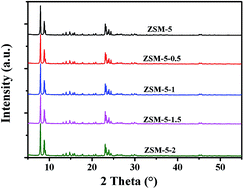Methanol to gasoline over zeolite ZSM-5: improved catalyst performance by treatment with HF†
Abstract
Zeolite ZSM-5 (SiO2/Al2O3 = 50) has been treated with hydrofluoric acid (HF) solutions, characterized with many techniques and studied in the conversion of methanol to gasoline (MTG). After the HF treatment, the crystallinity of the zeolite is retained; mesopores are generated and the mesopore volumes increase with the HF concentration; the SiO2/Al2O3 ratios increase; the acidities of the samples and the Brönsted acid sites decrease, while the Lewis acid sites increase with the HF concentration. Aluminum from the framework was removed to an extent by the treatment. With increasing the concentrations of HF solution in the treatment, the stabilities of the ZSM-5 samples improve significantly in MTG. The results demonstrate that the acidity and the pore structure are two crucial factors in determining the catalytic properties.

- This article is part of the themed collection: Zeolites and 3D Porous Solids

 Please wait while we load your content...
Please wait while we load your content...